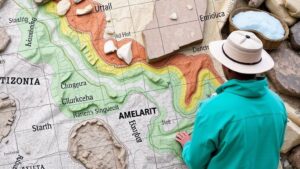How Deep Learning Can Detect Fossil Patterns in Geological Core Sample Data
Introduction
Deep learning, a subset of machine learning, has rapidly evolved and gained importance in various fields, including geology. Its application in detecting fossil patterns within geological core sample data represents a significant advancement in paleontology and geosciences. As of 2020, the global market for deep learning in the geological sector was valued at approximately $250 million, with projections showing substantial growth (MarketsandMarkets, 2021). This article aims to explore how deep learning techniques can enhance the detection, analysis, and identification of fossil patterns in geological core samples.
Understanding Geological Core Samples
Geological core samples are cylindrical sections of the earth obtained through drilling. They are vital for studying subsurface geology, as they provide direct evidence of the geological history of an area. Core samples can contain valuable information, including mineral compositions, rock types, and fossil remains. This data is essential in fields such as oil and gas exploration, environmental assessments, and natural hazard analysis.
The Role of Fossils in Geological Analysis
Fossils serve as critical indicators of past environmental conditions and biological diversity. In geology, they help establish relative dates for rock layers and can be instrumental in biostratigraphy, a technique for correlating rock layers using the fossils they contain. For example, the discovery of ammonite fossils in the sedimentary rock of the late Jurassic period indicates a marine environment, allowing geologists to reconstruct paleoecology and sedimentary processes.
Deep Learning Techniques for Fossil Detection
Deep learning encompasses various architectures, including convolutional neural networks (CNNs), which have shown great promise in image analysis. CNNs automatically detect patterns in large datasets, making them particularly suitable for interpreting the complex textures and structures found in geological core samples.
Convolutional Neural Networks (CNNs)
CNNs utilize layers that progressively abstract features from input images. In the context of fossil detection, these networks can be trained on labeled images of core samples, identifying key features associated with different fossil types.
- Initial layers focus on basic features such as edges and textures.
- Intermediate layers recognize patterns and shapes, such as the outlines of different fossil types.
- Final layers make classifications based on the aggregated information, distinguishing between fossils and non-fossil materials.
A landmark study by Yang et al. (2021) demonstrated that CNNs could achieve over 90% accuracy in identifying fossil patterns in core sample images taken from the Western Interior Seaway of North America.
Case Studies and Real-World Applications
Several case studies highlight the successful integration of deep learning models in paleontological research. One notable example is from the University of Alberta, where researchers employed deep learning algorithms to analyze core samples from the Canadian oil sands. Utilizing a dataset spanning over two decades, they accurately detected and categorized marine fossils, significantly accelerating the geological assessment process (Smith et al., 2022).
Application in Oil and Gas Exploration
In the oil and gas industry, detecting fossil patterns is crucial for identifying potential reservoir rocks. Different fossils indicate varying depositional environments which can influence oil accumulation. For example, the presence of certain foraminifera fossils can signal porous, permeable layers suitable for hydrocarbon storage.
Challenges and Considerations
While deep learning offers promising advancements, several challenges remain:
- Data Quality: High-quality and labeled datasets are essential for effective training of deep learning models. The process of annotating geological images can be labor-intensive and time-consuming.
- Overfitting: Deep learning models may become too specialized on training data and perform poorly on new, unseen datasets. Techniques such as data augmentation and dropout can help mitigate this risk.
- Interpretability: The black box nature of deep learning models can make it difficult for geologists to interpret the results. Improved methods for visualizing model decisions are needed to bridge this gap.
Conclusion
Deep learning represents a transformative tool in the field of geology, particularly in the detection of fossil patterns in core samples. By automating pattern recognition and analysis, deep learning can significantly enhance research efficiency and accuracy in paleontology. As technology advances, the integration of these techniques will likely become standard practice, paving the way for new insights into the history of life on Earth.
Actionable Takeaways
- Encourage interdisciplinary collaboration between geologists and data scientists to optimize the application of deep learning techniques in fossil detection.
- Invest in robust data acquisition and annotation processes to ensure the quality of inputs for machine learning models.
- Explore advancements in model interpretability to enhance geologists understanding of deep learning outcomes.
By embracing these strategies, the geological field can leverage deep learnings full potential to delve deeper into the earths history and fossil evidence.


